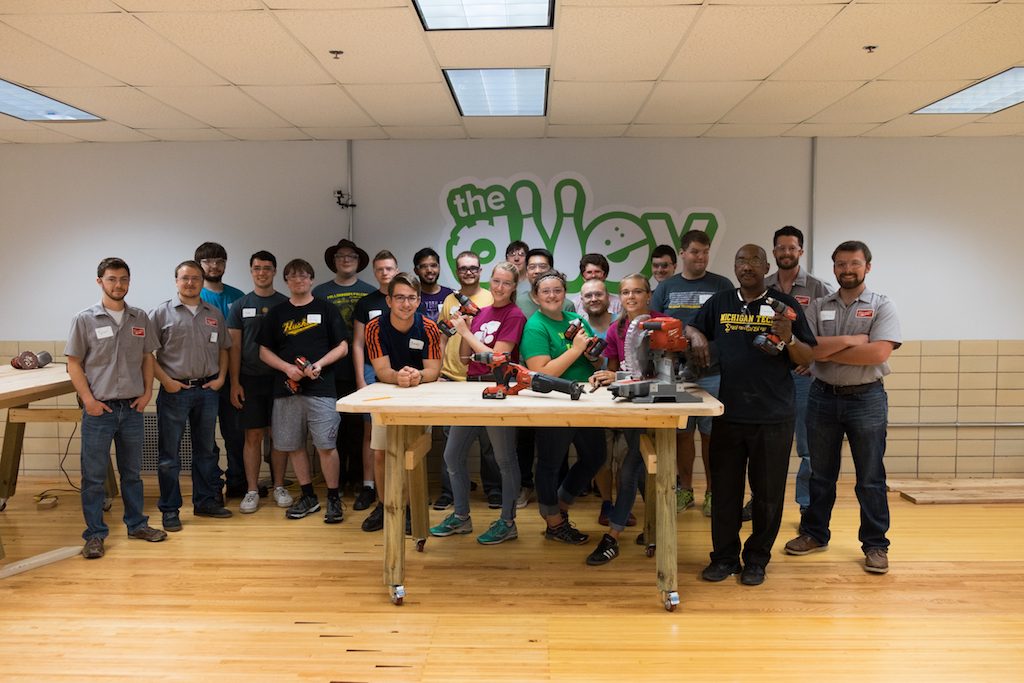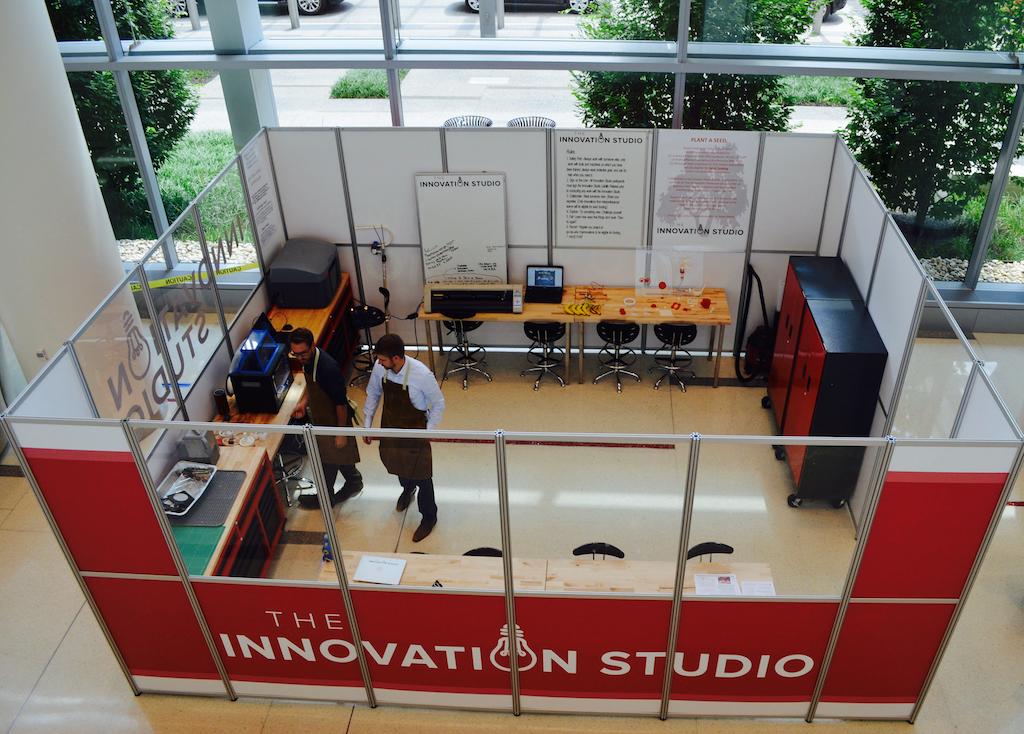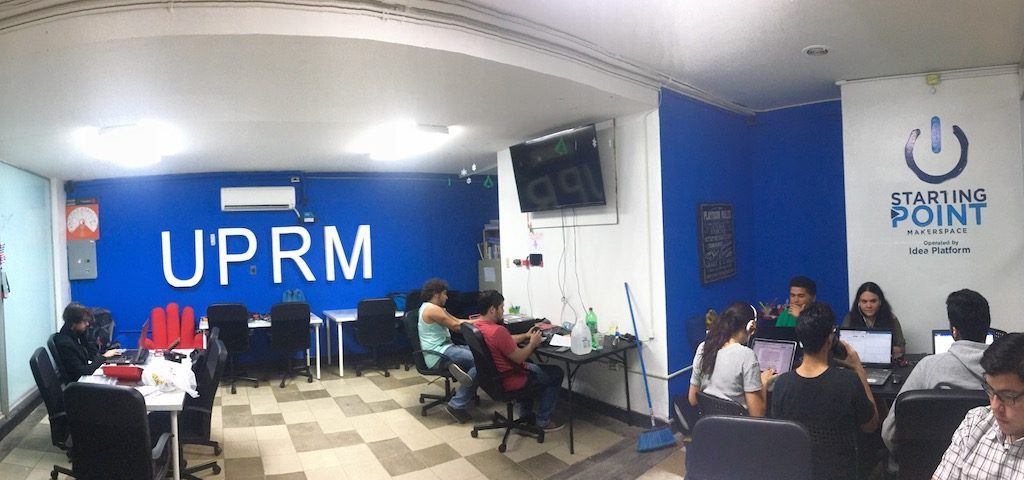
Universities are increasingly investing in makerspaces. But what are they, exactly? Makerspaces have a broad definition. They’re loosely described as spaces where students can hash out ideas and bring inventions to life. Often stocked with both low- and high-tech equipment, these spaces allow student innovators to create real prototypes, and serve as starting places for students to launch startups, get advice about bringing a product to market, and network with alumni and potential funders.
Faculty also use makerspaces to meet a wide range of educational goals, from pragmatic (a space for students to complete class projects), to pedagogical (an active learning environment to foster deep learning), to institutional (increased sense of connectedness to the major), to meeting post-graduation goals (working on interdisciplinary teams).
No two makerspaces look the same, and they can be adapted to each university’s space limits, budgets, and imagination. VentureWell interviewed faculty from four different universities about their makerspaces on campus, ranging from small, movable rooms to renovated bowling alleys. In their own ways, each makerspace is spurring innovation on campus and instilling an entrepreneurial mindset.

The Alley
Michigan Technological University
Mary Raber, Assistant Dean of Academic Programs and C0-Director of the Innovation Center for Entrepreneurship
The specs: The Alley is a 4,000-square-foot renovated bowling alley in the basement of the school’s Memorial Union Building. “We looked around campus for quite awhile trying to find a suitable space,” Raber says. “We are a good example of what you can accomplish on a very small budget. We’ve treated this like a living model of the design thinking process. If it doesn’t work, we go back to the drawing board.”
The equipment: A sewing machine, arts and crafts supplies, a forthcoming electronic workbench, woodworking tools donated by Milwaukee Tool, an X-Carve, a 3D printer, and a lounge with movable student-built tables
Programming: The space is used to host a series of workshops on topics including 3D modeling, building a website, and using X-Carve.
Point-of-pride: First opened in October 2016, the Alley saw 700 unique users in its first full semester of operation, at a ratio of 50/50 male and female.
What’s unique: The space was designed collaboratively by the Michigan Tech community, who were invited to attend a design-thinking event to visualize and plan the makerspace. “Engaging the campus community and gaining buy-in and ideas up front was essential,” Raber says.
The impact: “This space is unleashing students’ creativity and bringing their ideas to life,” Raber says. “It’s giving us a place where we can educate students more deliberately about the process of innovation and the importance of it to the eventual careers, whether they work for someone else or start their own company.”
Advice for other schools: “We brought our safety people in right from the start,” Raber says. “That was essential. We heard concerns that it’s too dangerous to just turn this space over to students with equipment in it. We satisfied their concerns by having the safety people in from day one.”
Developing an entrepreneurial mindset: “We feel pretty strongly that the characteristics of an entrepreneurial mindset, and that innovation, ideation, and problem identification, are essential to a student’s education and will be useful skills regardless of where their careers take them,” Raber says.

The Innovation Studio
Ohio State University
Tim Raderstorf MSN RN, Chief Innovation Officer
The specs: Run by the College of Nursing, the Innovation Studio is a 16-by-16 foot movable, adaptable makerspace that travels from college to college across Ohio State’s vast campus for two month residencies. The space is smartly designed to be torn down and reconstructed in an afternoon. “If we had just put [the makerspace] in the College of Nursing, or if we just put it in the hospital, then only the people who work in those spaces would engage in it,” Raderstorf says. “There’s not a lot of cross-pollination between colleges. We want to be able to move this space across campus to foster more engagement with diverse disciplines.”
The focus: The Innovation Studio serves the entire university and is focused on interprofessional teams creating products, services, and solutions that impact health and wellness.
The equipment: The space includes two 3D printers, a laser cutter, hand tools, computing hardware, a vinyl cutter, and butcher block workspaces.
Programming and support: The Innovation Studio hosts workshops with topics such as product design and pitch development, and provides project mentors and daily technical support. “Students come to us with their idea. We’ll provide them with the tools, mentorship, and resources to help guide them in the right direction,” Raderstorf says.
Point-of-pride: Along with the Open Healthcare Innovation Track during each seven-week session, where anyone can use the space to develop an interprofessional team to develop a healthcare innovation, students, faculty, and staff can alternatively focus on a Challenge Track. Currently the Challenge Track focusses on a key area of interest for the host location, and the team has big aspirations for its potential. “Our hope is that the Challenge Track will become our sustainability model where we’re able to partner with a large organization to challenge us saying, ‘Hey, instead of developing something new, why don’t you look at this product line, put your best teams on it, and we’ll sponsor you at $50k or $100k to deconstruct it and allow us to engage in the process.”
The impact: Of the five student-focused teams that have come through the space, Raderstorf has recommended three to become a VentureWell E-Team. One team he recommended move directly to E-Team Stage 2. “We’ve been able to pull business students into our program,” Raderstorf says. “Even if you don’t have an idea, a nurse and pre-med student might have one, but they need someone with a business background to round out their team. So we’re really able to help mentor them and build their network.”
Advice for other schools: “Our space has glass windows on two sides to make sure we’re sparking people’s curiosity,” Raderstorf says. “You see someone walking by slowly to see what’s happening inside. That’s when you go out and say, ‘Hey, why don’t you come in and check things out?’”
Entrepreneurial viewpoint: “Our makerspace is teaching students how to identify opportunities, how to evaluate policy, and see if there’s any changes that are coming down the pike that may allow them to change the way that they practice,” Raderstorf says. “Or develop a new product, service, or solution that could change the way that everyone practices, and do that from an entrepreneurial viewpoint.”

Spark Innovation Studio
Kent State University
Julie Messing, Executive Director, Entrepreneurship Initiatives
The specs: Spark is a 2,400-square-foot multipurpose makerspace with two distinct working areas: a makerspace and a project studio space, which is allocated to student teams working on making, creating, and research. “We already had 20 makerspaces on campus, but most of them were closed to students not in a certain major,” Messing says. “We didn’t have an open-use facility. Where normally it is very isolated, I think Spark opens the doors to cross-university collaborations to levels we haven’t seen before.”
The equipment: Three 3D printers, including a liquid resin 3D printer, a vinyl cutter, a direct-to-garment printer, a laser cutter and engraver, an X-Carve CNC router
Programming and support: Under the direction of University Libraries, the makerspace is affiliated with LaunchNET and the Student Multimedia Studio at Kent State—both of which provide resources and support to student entrepreneurs. The LaunchNet program helps students with a variety of startup-related activities, from ideation to pitching to network development. The Multimedia Studio allows students to work on multimedia projects. “We want to remind people that they don’t need to leave campus to go through early stage development,” Messing says. “Students have the resources right here.”
Point-of-pride: A physical map that displays all of the makerspaces on campus, and includes availability, location, equipment, and restrictions.
The impact: Student innovators from multiple disciplines are using Spark, LaunchNET, and the Student Multimedia Studio to develop a range of innovations, including a keyboard for language translation, a phone case that doubles as an epi pen case, and a device to sanitize hands in developing countries. Messing says cross-university collaboration “moves things to markets much faster and it opens people up to a lot more creativity when you’re breaking people out of their silos.”
Advice for other schools: Get buy-in from other colleges across campus who have their own makerspaces. Give them an opportunity to participate or contribute to the development in some way.
Excitement grows: “Anyone can be an innovator,” Messing says. “The language student developing a translation keyboard didn’t know where to start. His connections were within the language program. By working with Spark, LaunchNET, and the Multimedia Studio, he’s been able to expand the network and realize that he can be an innovator.”

Starting Point
University of Puerto Rico
José E. Lugo, Assistant Professor, Department of Mechanical Engineering
The Specs: A 500-square-foot renovated copy room and closet in the Student Center. “We saw how a makerspace is part of the equation to have a thriving entrepreneurial ecosystem,” Lugo says. “We had bits and pieces of a makerspace, but it was spread all around campus and it was owned by different groups. It wasn’t open to all students.”
The equipment: Currently, Starting Point has a 3D printer, tables, chairs, boards, Arduinos, and TV used as a display in workshops. A forthcoming expansion will include power tools and prototyping machinery.
Working with a small space: “We are smaller institution, and real estate is limited. We discovered that you just need a room to start. We’re evolving from there,” Lugo says.
Programming and support: The space is used for workshops, including topics on design thinking and building an app. A student association runs office hours in the space, providing advice and support.
Point-of-pride: Using the makerspace is completely free for students.
The impact: Many entrepreneurial teams are using the space for meetings and networking, and VentureWell E-Team, Blu Horizon, has used the space. Blu Horizon is developing a sensor that can be placed in a water main or supply line in order to track household water usage. The sensor reports water usage to a mobile app in order to show users how much water their household is using.
Advice: “As for a space, it doesn’t matter the size,” Lugo says. “It also could be the library, which the students don’t see as engineering territory, or arts territory. It’s neutral ground, and it should be centrally located on campus.”
On the horizon: “I think the message of our makerspace is that you can invent and feel free to make stuff at the university,” Lugo says. “All students can be inventors and entrepreneurs. I’m looking forward to expanding our space more.”
According to these four faculty members, the best makerspaces aren’t always the fanciest, with the latest laser cutters or swanky lounge furniture. Effective makerspaces respond to the needs of the students and faculty, are accessible, and are open to all departments and colleges. Building a makerspace doesn’t automatically mean students will come; our interviewees recommend making it easy to sign up, learn how to use the equipment, and seek advice from coaches and mentors volunteering or working in the space. Hosting workshops, seminars, and classes in the makerspace introduces more students to the possibilities of the space, helping them realize they could translate a big idea into a real invention or solution. In all, a makerspace is about the power of suggestion: that anything is possible.